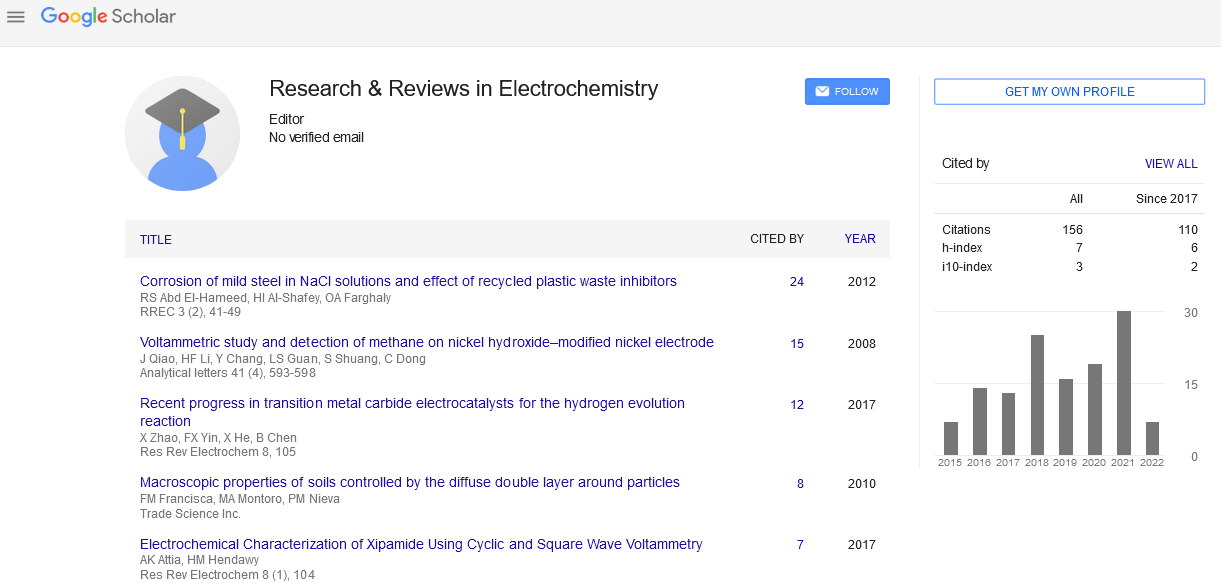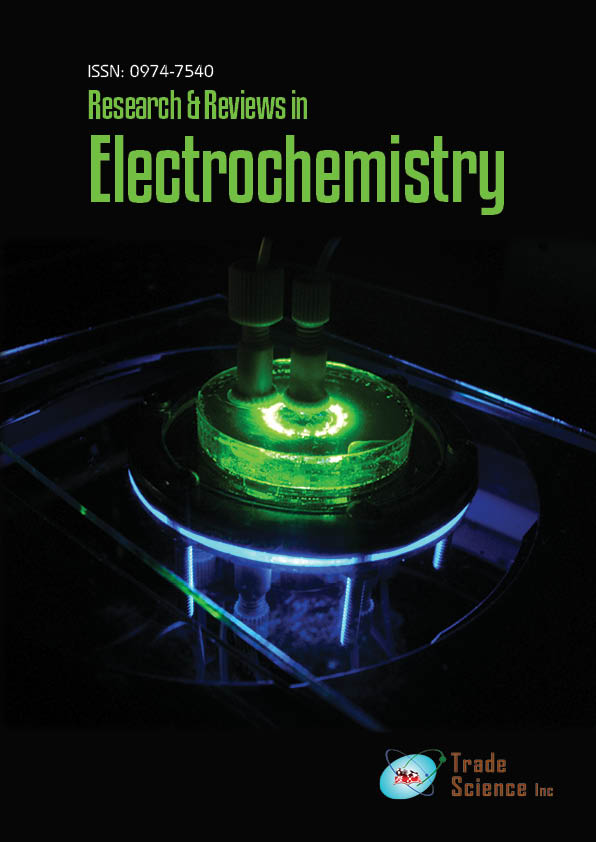Short communication
, Volume: 8( 1)Improving the Ion Diffusivity in Lithium Ion Batteries Using Hybridized Nanostructure Tin Selenide/PEDOT: PSS Electrodes
- *Correspondence:
- Yongjie Hu , Department of Mechanical and Aerospace Engineering, University of California, Los Angeles, CA, 90095, USA, E-mail: yhu@seas.ucla.edu
Received: April 14, 2017; Accepted: April 29, 2017; Published: May 04, 2017
Citation: Nguyen H, Ke M, Hu YJ. Improving the Ion Diffusivity in Lithium Ion Batteries. Using Hybridized Nanostructure Tin Selenide/PEDOT:PSS Electrodes. Res Rev Electrochem. 2017;S1:103.
Abstract
We investigated the effect of poly (3,4-ethylene dioxythiophene): poly (styrene sulfonate) (PEDOT:PSS) on the lithium ion diffusivity in a tin selenide (SnSe) nanostructured electrode. Characterization of the SnSe/PEDOT:PSS electrodes was done using galvanostatic intermitten titration technique and electrochemical impedance spectroscopy. Our results show that, by hybridization using PEDOT:PSS, ion diffusivity in the electrode can be significantly enhanced while the battery impedance is preserved.
Keywords
Lithium ion batteries; Tin Selenide electrodes
Introduction
Recently, there have been intensive studies to use nanostructured electrodes to improve the performance of batteries and supercapacitors with respect to high energy and power density, and charging rate [1-6]. The rational design of nanostructures can provide flexible control and new electrochemical functionality beyond the bulk forms [7]. However, one common issue in nanostructured electrodes is the degraded ionic diffusivity and interface scattering when excessive amount of traditional binders is added. Some research efforts have been explored to focus on the interface ion and charge transport between nanostructures and binder additions. Specifically, the poly (3,4-ethylene dioxythiophene): poly (styrene sulfonate) (PEDOT:PSS), a prototyped conducting polymer, has been recently studied as a functional binder and electrical conduct additive in battery electrodes [7-12]; however, the effect of PEDOT:PSS on the lithium ion diffusivity has not yet been explored. In this report, we report the first investigation into the effect of PEDOT:PSS on lithium ion diffusivity in nanostructured tin selenide nanoflower (SnSe NF) electrodes. The galvanostatic intermitten titration technique (GITT) [13] was used to determine the effect of PEDOT:PSS on the diffusivity of lithium ion in SnSe electrode. Our results reveal significant improvement in ionic diffusivity by more than one order, and represent the first step to investigate the interfacial ion and charge between the hybridized organic-inorganic interfaces.
Experimental
SnSe NFs are synthesized through solution chemical reaction . First, SnCl4•5H2O (0.1 mmol, 140 mg), SeO2 (0.1 mmol, 44 mg), and oleylamine (~ 30 mmol, 20 mL) were added into a three-neck flask at room temperature. The flask is sealed and the mixture is stirred continuously for five minutes. Afterwards, the mixture is sonicated for 30 minutes at room temperature. The mixture is degassed with pure N2, and then aged at 150°C for 10 minutes while being stirred continuously under N2 atmosphere. Subsequently, the mixture is slowly heated to 350°C at rate ~10°C/min and aged at 350°C for 15 to 20 minutes. After this process, SnSe NF is extracted by centrifugation and then cleaned with excess ethanol. SnSe NF is then dried and stored.
PEDOT:PSS is prepared by filtering PEDOT-PSS (CleviosTM PH1000, Heraeus) through a 0.45 μm filter and then mixing the solution with 5% volume dimethyl sulfoxide (DMSO) [14]. The SnSe/PEDOT:PSS electrodes are prepared by mixing SnSe NF and PEDOT:PSS (solid PEDOT:PSS ~8.5 wt %) with IPA then drop-casted onto a stainless steel disk and air dried for ~30 min. Afterwards, the electrode is annealed at 80°C for another 30 min. Pure SnSe electrodes are prepared using the same procedure but with the absence of PEDOT:PSS.
The batteries are fabricated using the as prepared SnSe/PEDOT:PSS electrodes as anode, Li metal as cathode, Celgard separator and 1M LiPF6 EC/DEC (1:1 vol) as electrolyte. The layers are assembled into coin type LIR2032 battery and air-tight sealed with epoxy. The ion diffusivity inside the SnSe electrodes is determined by galvanostatic intermitten titration technique (GITT) with VSP-300 (Biologic). We also performed electrochemical impedance spectroscopy to determine the effect of PEDOT:PSS on battery impedance.
Discussion
The structure of the as prepared SnSe was examined by SEM. Figure. 1a, shows the SEM image of the SnSe NF. The SEM shows that SnSe NF’s structure is an assembly of SnSe nanoplates in a flower-like structure in which each nanoplate served as a “petal” for the flower structure. The length of each structure is around 1 μm ~ 2 μm; however, the structure is not in spherical shape like in previous hydrothermal synthesis [15]. We believe the difference is due to the synthesis of SnSe NF took place at higher temperature than the reported temperature. Figure. 1b and 1c, shows the electrodes with pure SnSe NF and SnSe NF mixed with PEDOT:PSS respectively.
Figure 1: (a). SEM of SnSe NF, the length of the black bar is 2 µm. (b) electrode with pure SnSe NF and (c). SnSe NF mixed with PEDOT:PSS.
We used GITT to estimate the lithium ion diffusivity in our electrodes. We applied constant current (1 μA) for 5s to observe the voltage responds of the electrodes and plotted our results in Figure. 2a and 2c, for pure SnSe and SnSe/PEDOT:PSS electrodes respectively. From our data, we estimated the ion diffusivities are 2.9 × 10-14 m2/s and 3.7 × 10-13 for pure SnSe and SnSe/PEDOT:PSS electrode respectively. Data show that PEDOT:PSS increases the ion diffusivity by an order of magnitude. We attribute this phenomenon to poly (styrene sulfonate) (PSS) binding to lithium ion to form poly (lithium 4-styrene sulfonate) (LiPSS) [16], thus facilitating lithium ions to more readily diffuse across the electrode.
We measured the impedance of the electrodes by scanned the frequency of current from 1 MHz to 1 Hz with a fixed amplitude (1 μA) (Figure. 2b and 2d). No significant change in the impedance has been observed, which means that the ionic conductivity inside the electrode is not affected by adding PEDOT:PSS. This result suggests that, unlike the conventional battery binders such as PVDF where deleterious interface insulation effects were largely reported in literature [17], PEDOT:PSS maintains good interface transport. This also explains why the high capacity of the battery remains without significant degradation even at high charging and discharging rates. Our results show that PEDOT:PSS does not have interface insulating effect, instead it enhances ion diffusivity. This suggests that PEDOT:PSS provides better charge transfer than the traditional binders.
Conclusion
In this paper, we studied the effect of PEDOT:PSS on lithium ion diffusivity. The GITT data show that PEDOT:PSS increases the ion diffusivity by an order magnitude. We speculated that the increase in ion diffusivity is due to lithium ion and PSS reaction to form LiPSS, which allows the lithium ions to diffuse across electrode more easily by hopping from one binding site of PSS to another. Based on the impedance spectroscopy measurement, the quality of interfacial transport between SnSe/PEDDOT:PSS and SnSe electrodes is maintained. Our study implies that hybridized battery electrodes with PEDOT:PSS can facilitate faster charge transfer in lithium ion batteries and provide a better alternative to traditional battery binders.
Acknowledgements
Y.H. acknowledges support from the Young Investigator Award through the US Air Force Office of Scientific Research and the Sustainable LA Grand Challenge and the Anthony and Jeanne Pritzker Family Foundation.
References
- Lu J, Chen Z, Ma Z, et al. The role of nanotechnology in the development of battery materials for electric vehicles. NatNanotechnol. 2016;11(12):1031-8.
- Yang Y, Zheng G, Cui Y. Nanostructured sulfur cathodes. Chem Soc Rev. 2013;42(7):3018-32.
- Tang Y, Zhang Y, Li W, et al. Rational material design for ultrafast rechargeable lithium-ion batteries. Chem Soc Rev. 2015;44(17):5926-40.
- Aricò AS, Bruce P, Scrosati B, et al. Nanostructured materials for advanced energy conversion and storage devices. Nat mat. 2005;4(5):366-77.
- Dunn B, Kamath H, Tarascon JM. Electrical energy storage for the grid: A battery of choices. Science. 2011;334(6058):928-35.
- Bonaccorso F, Colombo L, Yu G, et al. Graphene, related two-dimensional crystals, and hybrid systems for energy conversion and storage. Science. 2015;347(6217):1246501.
- Kang JS, Ke M, Hu Y. Ionic intercalation in two-dimensional van der waals materials: In situcharacterization and electrochemical control of the anisotropic thermal conductivity of black phosphorus. Nano Lett. 2017;17(3):1431-8.
- Ai G, Dai Y, Ye Y, et al. Investigation of surface effects through the application of the functional binders in lithium sulfur batteries. Nano Energy. 2015;16:28-37.
- Das PR, Komsiyska L, Osters O, et al. PEDOT: PSS as a functional binder for cathodes in lithium ion batteries. JElectrochem Soc. 2015;162(4):A674-8.
- Ma T, Zhao Q, Wang J, et al. A sulfur heterocyclic quinone cathode and a multifunctional binder for a high-performance rechargeable lithium-ion battery. Angewandte Chemie International Edition. 2016;55(22):6428-32.
- Shao D, Zhong H, Zhang L. Water-soluble conductive composite binder containing PEDOT: PSS as conduction promoting agent for si anode of lithium-ion batteries. ChemElectroChem. 2014;1(10):1679-87.
- Yang Y, Yu G, Cha JJ, et al. Improving the performance of lithium-sulfur batteries by conductive polymer coating. ACS nano. 2011;5(11):1679-87.
- Bard AJ, Faulkner LR. Fundamentals and applications. Electrochemical Methods. 2nd edition. New York: John Wiley & Sons, 2000.
- Ju H, Kim J. Chemically exfoliated SnSe Nanosheets and their SnSe/poly (3, 4-ethylenedioxythiophene): poly (styrenesulfonate) composite films for polymer based thermoelectric applications. ACS nano. 2016;10(6):5730-9.
- Li L, Chen Z, Hu Y, et al. Single-layer single-crystalline SnSe nanosheets. J Am Chem Soc. 2013;135(4):1213-6.
- Park CH, Sun YK, Kim DW. Blended polymer electrolytes based on poly (lithium 4-styrene sulfonate) for the rechargeable lithium polymer batteries. Electrochimica acta. 2004;50(2):375-8.
- Zheng H, Yang R, Liu G, et al. Cooperation between active material , polymeric binder and conductive carbon additive in lithium ion battery cathode.J Phys Chem C.2012;116:4875-82.



